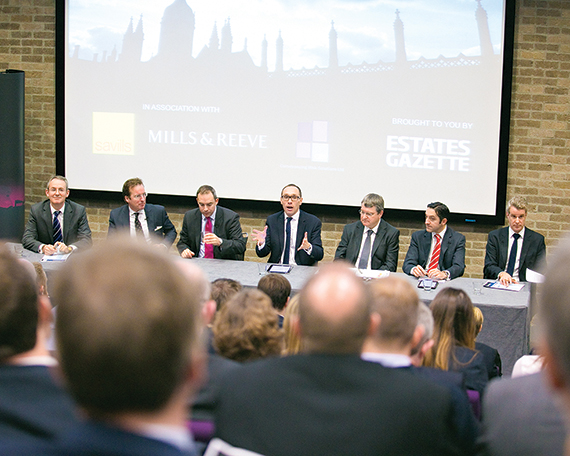Some 200 property professionals crowded into Clare College in Cambridge as experts gathered to debate the booming sectors in the city
Cambridge’s commercial property market is going from strength to strength thanks to a booming tech economy, but the city must urgently address the issue of its strained infrastructure, according to a panel of experts at EG’s final Question Time of 2014.
Rob Sadler, Savills’ head of office in Cambridge, said: “Historically, Cambridge has been built on home-grown businesses or companies linked to the university. Now we are drawing major global corporations such as Apple and AstraZeneca.”
News emerged last month that Apple was looking at taking around 10,000 sq ft at Endurance Developments’
and Freshwater’s 90 Hills Road for an R&D centre and offices. The move would further validate Cambridge as a magnet for tech occupiers, even as London’s Silicon Roundabout expands.
Vincenzo Maggio, partner at Mills & Reeve, said that occupier demand from the biotech and IT sectors was so strong in Cambridge that east London’s tech cluster was complementary to the city, rather than a threat.
But Sven Topel, chief executive of Brookgate, which is developing the 25-acre mixed-use CB1 scheme, said the phenomenon of “reverse commuting” meant that huge numbers of workers were travelling into Cambridge from London every day, which is putting a strain on existing transport infrastructure.
Maggio said Cambridge needed to work on providing better connections between the station and outlying science parks in order to avoid excessive congestion. “Once you’ve got into Cambridge, you need to be able to move around,” he said. “There has got to be better public transport. Granta Park has a shuttle bus for its employees that carries the company’s branding and passes through the city centre multiple times a day. It’s a short-term fix, but other companies could follow suit. It would ease congestion and give brand exposure to property companies – maybe Cambridge should have a ‘Brookgate bus’.”
The audience also heard that the city needed to “push harder” for more residential development to accommodate a growing population. Edward Skeates, project director at Grosvenor, said: “We need up to 15,000 new homes in the next 10 years. There are 6,000 unbuilt homes in Cambridge which already have planning consent.”
Grosvenor, which has had a presence in the Cambridge market since 1983, is currently working on the development of 1,200 new homes at Trumpington Meadows in partnership with the £40bn Universities Superannuation Scheme, one of the UK’s biggest pension funds.
A drive for residential development in peripheral areas such as Waterbeach and Northstowe must be combined with efforts to improve road and public transport links with the centre, Topel said. “The A14 is heavily congested and it is holding back developments to the north of the city,” he added.
Northstowe is a government-backed masterplanned development that will bring around 9,500 new homes to Cambridge. The panel agreed that satellite towns not only needed to be connected, but must have a “sense of community”.
“We need to promote the growth of jobs and economic activity in outlying towns, not just homes,” said Simon Payne, director of environment at Cambridge city council.
But there was disagreement over developing the city’s green belt. “The green belt is still really important for Cambridge. However, we have released a substantial amount of land for development through the 2006 local plan,” said Payne.
Skeates called for a radical overhaul of the city’s use of land. “We need green space but this isn’t the way to provide it,” he said.
Cambridge at a glance
Cambridge is one of the UK’s most mature tech and science clusters; 1,400 companies have been set up there in the past 50 years and employ some 40,000 people.
However, the city faces a crunch on office space thanks to this high demand from tech occupiers. There is less than 20,000 sq ft available in the Hills Road/Station Road area, and less than 75,000 sq ft in the northern cluster.
However, up to 253,500 sq ft of new office space is currently under development, which should help to ease the shortage. This includes Brookgate’s 129,000 sq ft One The Square and XLB Property’s 40,000 sq ft CPC2 at Capital Park.
Supply of laboratory stock is also at critically low levels, with only 38,500 sq ft available for rent.
According to Savills, city centre office rents are £33 per sq ft but are projected to rise to £37 by 2017. Rents in the northern cluster and eastern side of Cambridge are £26.50 per sq ft and are expected to rise to £30 by 2017. Prime laboratories are currently £24 per sq ft (including shell and core) but are expected to rise to £30 per sq ft by 2017.
Twitter talk #EGQT
@SophiaFurber: Edward Skeats, Grosvenor: the green belt is an anachronism. We need green space but this isn’t the way to provide it #EGQT @estatesgazette
@RichardMaung, Deloitte: has #Cambridge been complacent about @TechCityUK? Can the two work together? #EGQT
@Estates Gazette: Granta Park shuttle bus is good advertising, says Vinny @millsandreeve. Maybe Brookgate will catch on. Cheeky! #EGQT
@Bekspakzek: City forecast to grow 25%, 14,000 new homes & 20,000 jobs. Needs considered development in city and surrounding areas #EGQT
@Bekspakzek: Edward Skeates from Grosvenor – city needs considered devel. Need new pipeline of up to 15,000 homes using cross-authority networks. #EGQT
@RichardMaung: view that Cbg must deliver the resi it has promised during the local plan period. Too many units with consent remain unbuilt #EGQT
@SophiaFurber: Rob Sadler, Savills: Cambridge was always built on smaller, home-grown businesses. Now we are seeing major corporates such as Apple, AZ #EGQT











